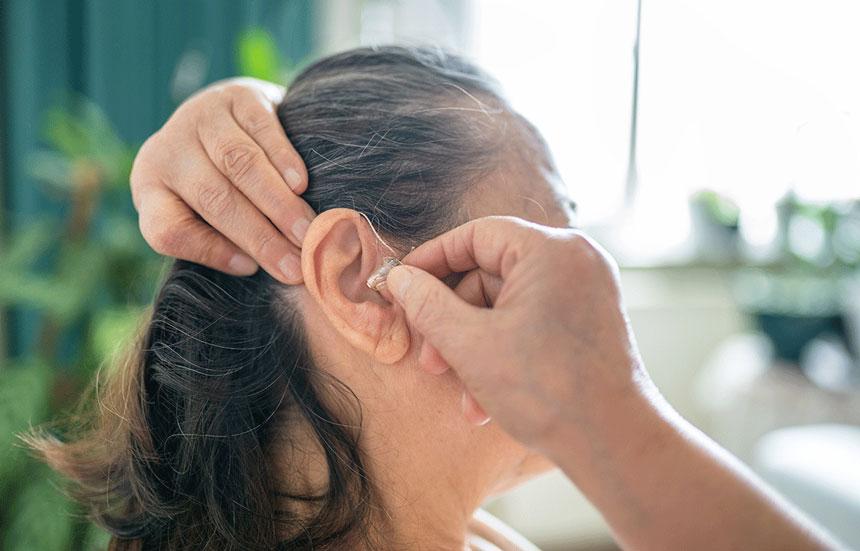Hearing Aids Can Improve Hearing and Protect Brain Health

Does it seem like everyone around you is mumbling? Do you often ask people to repeat themselves? Is it difficult to keep up with group conversations? Can you hear well on the phone? Do people complain that your TV is too loud? If you said yes to these questions, you may be a candidate for a hearing aid.
Most people are not thrilled to discuss hearing aids. But “hear” us out. If you need a hearing aid but skip getting one, you raise your risk for dementia. Eight percent of dementia cases are attributed to hearing loss, according to a study published in The Lancet. Hearing loss may even be an early symptom. And untreated mild hearing loss doubles the risk for dementia, moderate loss triples the risk and severe loss quintuples the risk, according to Johns Hopkins Medicine.
Researchers believe that hearing loss causes your brain to work harder to keep up with conversations, listen to music or watch television. The additional brain power allocated to hearing comes at the expense of brain power being used for cognitive skills, possibly affecting the brain. Studies have linked impaired hearing to brain shrinkage. Hearing loss also is notorious for causing social isolation, another known risk factor for dementia. Meanwhile, hearing aids have been shown to lower the risk of dementia to that of a person without hearing loss.
“Many of my patients had negative misconceptions about wearing a hearing aid,” says Bernard Kaminetsky, MD, medical director, MDVIP. “I explained to them wearing a hearing aid doesn’t make you old, incapable or less attractive; in fact, it’s the opposite. Wearing one can help you stay young and social, maintain your independence and prevent impairment. Many styles of hearing aids are small enough not to be seen.”
If you’re struggling to hear, talk to your primary care physician. Your PCP can examine your ears. If they find an infection or earwax, they can treat it. However, if they don’t see anything they may refer you to an otolaryngologist or audiologist for a hearing test and possibly, additional assessments. If warranted, a hearing aid for one ear (possibly both ears) may be recommended.
“The MDVIP Wellness Program often includes a pure-tone hearing test. MDVIP-affiliated physicians use results from this screening to refer patients to an audiologist,” says Kaminetsky. “Studies have found that patients far more likely to follow up with an audiologist when a PCP refers them.”
Selecting a Hearing Aid
Hearing aids work in the same basic manner. They have a microphone that picks up sound waves, converts them to electrical signals and sends them to an amplifier that transmits the sounds to the ear via a tiny speaker. But there are different styles and price points.
Before you buy a hearing aid, discuss your options with a professional. Become familiar with features some styles offer (e.g., noise reduction, directional microphones, volume control, rechargeable batteries, wireless connectivity, remote controls) and think about which ones you would value. Ask about a trial period and make sure you’re offered a warranty. Here’s an abbreviated version of Mayo Clinic descriptions of hearing aid styles.
Completely in the Canal (CIC) and mini CIC – is molded to fit the inside of the ear canal. This style helps improve mild to moderate hearing loss in adults.
- Pro: It’s the smallest and least visible style.
- Cons: Its very small batteries can be difficult to handle, and the speaker is susceptible to earwax clogging.
In the canal (ITC) - is custom molded to fit partially in the ear canal to help improve mild to moderate hearing loss in adults.
- Pro: It’s less visible in the ear than larger styles
- Cons: The smaller size can make it difficult to adjust and the speaker is susceptible to earwax clogging.
In the ear (ITE) – is custom made to either fit the bowl-shaped area of the outer ear or just the lower part of the ear. This style helps improve mild to severe hearing loss.
- Pros: The larger size and batteries make it easier to handle. Rechargeable battery is often a feature.
- Cons: The speaker is susceptible to earwax clogging. They also tend to pick up more wind than smaller devices.
Behind the ear (BTE) - hooks over the top ear and rests behind it. It’s connected to a tube with a custom earpiece that fits in the ear canal. This style helps improve mild to severe hearing loss for all ages.
- Pros: It’s larger, but streamlined, making it barely visible. The larger size enables directional microphones and better sound amplification. Rechargeable battery is a possible feature.
- Cons: This style tends to pick up more wind than smaller devices.
Receiver in the canal (RIC) or Receiver in the ear (RITE) – are like BTEs, but wire, instead of tubing, connects the earpiece to the speaker or receiver.
- Pros: It’s less visible than BTE and has manual control options and directional microphones. Rechargeable battery may also be a feature.
- Cons: The speaker is susceptible to earwax clogging.
Open fit – is similar to BTE with a thin tube or RIC or RITE with an open dome in the ear, keeping the ear canal open to allow low-frequency sounds to be heard naturally and higher frequency sounds to be heard via the hearing aid. This style helps improve mild to moderate hearing loss, particularly for those with better low-frequency hearing.
- Pros: Your voice sounds better to you.
- Cons: It’s a visible style. Can be difficult to insert into the ear.
“The best advice I can give patients is to be honest with yourself. If hearing has become a struggle, talk to your primary care doctor and follow their recommendations,” says Kaminetsky. “If a hearing aid is recommended, consult a professional before purchasing one.”
Don’t have a primary care physician? Consider joining an MDVIP-affiliated practice. MDVIP-affiliated physicians have more time to help you in your pursuit of a healthier lifestyle. Find a physician near you and begin your partnership in health »


